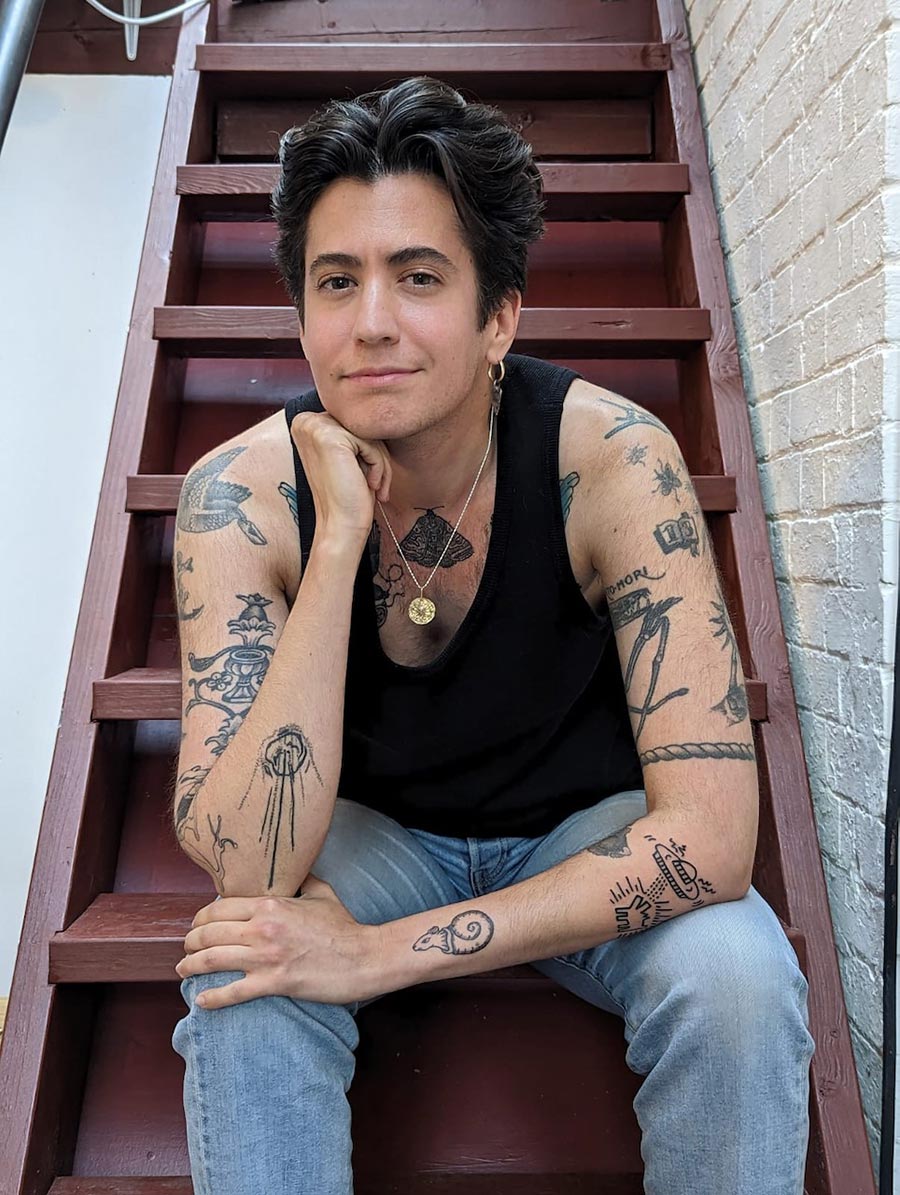
Brooke Palmieri, the 2023 writer-in-residence at The Huntington. | Photo by Jamie Bauermeister.
I have rarely entered a library or archive with intentions that would be clear to the person who created it, and The Huntington’s library is no exception. That doesn’t mean I haven’t found a warm welcome and kindred spirits during my time as a writer-in-residence here.
Part of the task of queering history is finding individuals in archives who were gender nonconforming in their time and place. But “queer” is a 500-year-old word meaning “strange, peculiar, odd, eccentric,” and so casting a wide net and looking back through a queer lens is also about taking into consideration how we’re looking. How can our methods of historical inquiry be more eccentric, centering different life stories and experiences? How have past people documented and described their world in ways more peculiar than we can possibly imagine? And how can we recover these stories from the places where they have managed to survive? The mix of trusting my instincts, scholarly discipline, and serendipity—which influences what is possible for me to find in collections like those at The Huntington—is a dreamy combination, creating ideal conditions for research and creative writing alike.
The notion of a library or archive created by and for queer and trans people is fairly new, and much work remains to be done to rediscover relevant materials in any library. Around the same time Henry E. Huntington started to amass his collection of rare books and manuscripts at the turn of the 20th century, the German sexologist Magnus Hirschfeld began building a collection of his own. Unprecedented for its time, Hirschfeld’s collection of materials related to gender and sexuality became the library at the Institut für Sexualwissenschaft (Institute for Sexual Science) in Berlin. Opened to the public in 1919, the library was run by one of Hirschfeld’s boyfriends, Karl Giese.
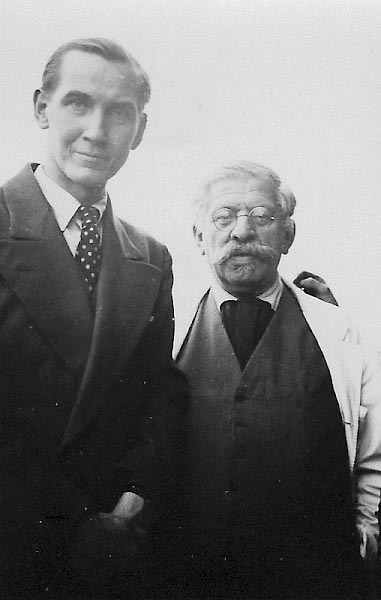
Karl Giese (left) and Magnus Hirschfeld, 1934. Photo from the archive of the Magnus-Hirschfeld-Gesellschaft in Germany. | Creative Commons Max Reiss-SA 3.0.
Christopher Isherwood described Hirschfeld and Giese’s relationship in his memoir Christopher and His Kind (1976):
As the short winter afternoon began to darken, they would visit Karl Giese for coffee and gossip. The atmosphere of Karl’s sitting room had none of the Institute’s noble seriousness; it was a cozy little nest, lined with photographs and souvenirs.
In repose, Karl’s long handsome face was melancholy. But soon he would be giggling and rolling his eyes. Touching the back of his head with his fingertips, as if patting bobbed curls, he would strike an It-Girl pose. This dedicated, earnest, intelligent campaigner for sexual freedom had an extraordinary innocence at such moments. Christopher saw in him the sturdy peasant youth with a girl’s heart who, long ago, had fallen in love with Hirschfeld, his father image. Karl still referred to Hirschfeld as “Papa.”
He told Christopher that all working-class boys who are homosexual have a natural urge to get themselves educated; therefore, they have to climb into the middle class. This was what Karl had done. Christopher felt shocked by his statement and didn’t want to admit that it was true. Why couldn’t a working-class boy become educated without acquiring bourgeois airs and graces? If his nature required him to be a queen, why couldn’t he be a working-class queen?
Giese, queen of the library, had a hand in decorating the Institute for Sexual Science, offered tours to its visitors, and occasionally appeared in drag. He also witnessed the Institute’s destruction by the Nazis in 1933. If you have seen the photographs of Nazis burning books, chances are you have seen parts of the Institute’s library on fire. Giese fled to Switzerland to meet Hirschfeld and Hirschfeld’s other boyfriend, Li Shiu Tong, and described to them the destruction of the library and, with it, the forestalling of Hirschfeld’s dream of toleration for queer and trans people.
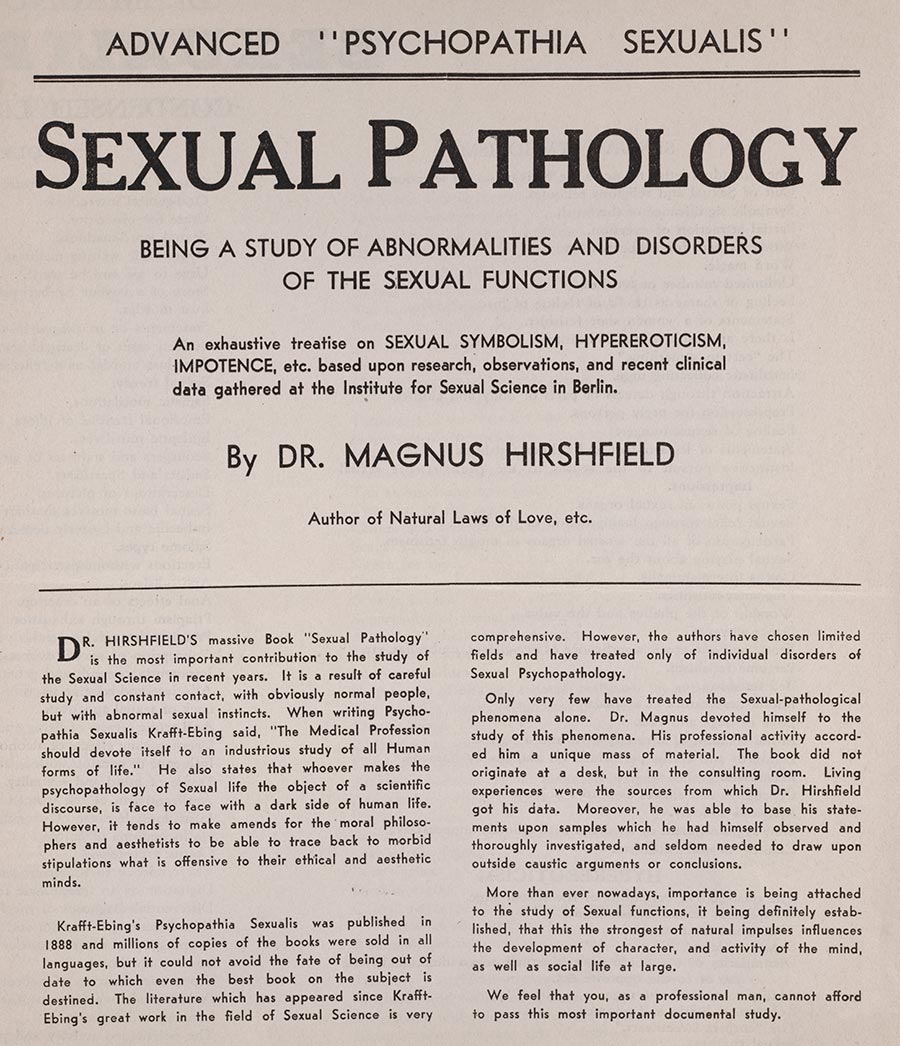
Advertisement for Magnus Hirschfeld’s Sexual Pathology, 1932, published by the Julian Press. Included in RB 623859, folder 1. | The Huntington Library, Art Museum, and Botanical Gardens.
Part of the work of reconstructing the parameters of Hirschfeld’s dream—which he meticulously articulated and advocated for through the sheer bulk of his research, archive, and library—is to trace its survival elsewhere, scattered across other libraries. By reconstituting and re-imagining where LGBTQIA+ rights have come from, we can more quickly exceed the limited vision of a single person. Any library and archive can then begin to do the work of Hirschfeld’s library and archive.
Library collections are created during their owners’ lives and sometimes dismantled after their deaths, or they cease to exist as the result of armed conflict or natural and other types of disasters, such as a house fire. Historical artifacts change hands by intent or by chance and are given new meaning in the context of new environments and in the hands of new people. The story of any given library collection often shifts and changes dramatically before I ever touch its contents. This is true of the American and British gentlemen’s libraries that Henry Huntington purchased until his death in 1927, and of the development of those core collections to the present day. They were and always have been dynamic entities.
At The Huntington, for instance, the only mention I found of Hirschfeld’s work came—as many traces of queer history do—in the form of absence. Hirschfeld is mentioned in a box of publisher and bookseller catalogs and prospectuses focused on sexuality and erotica, mostly from the 1930s and 1940s, which includes advertisements for books by Hirschfeld that The Huntington did not acquire. The publishers of these titles, better known for issuing subscription-based pornographic works disguised as anthropological studies, operated illegally on the margins of the industry. And even the booksellers who sold these books, like the famous Argus Book Shop in Chicago, issued discreet catalogs separate from their general stock. And yet, the advertisements were printed at the same time Hirschfeld’s library and his own publications were publicly burned. Moving between the constraints of burning books on one side of the ocean and banning books on the other, these advertisements become a thread to follow—a way of building a wider understanding about the relationship between what survives from the past and how that information is or is not incorporated into our sense of history.
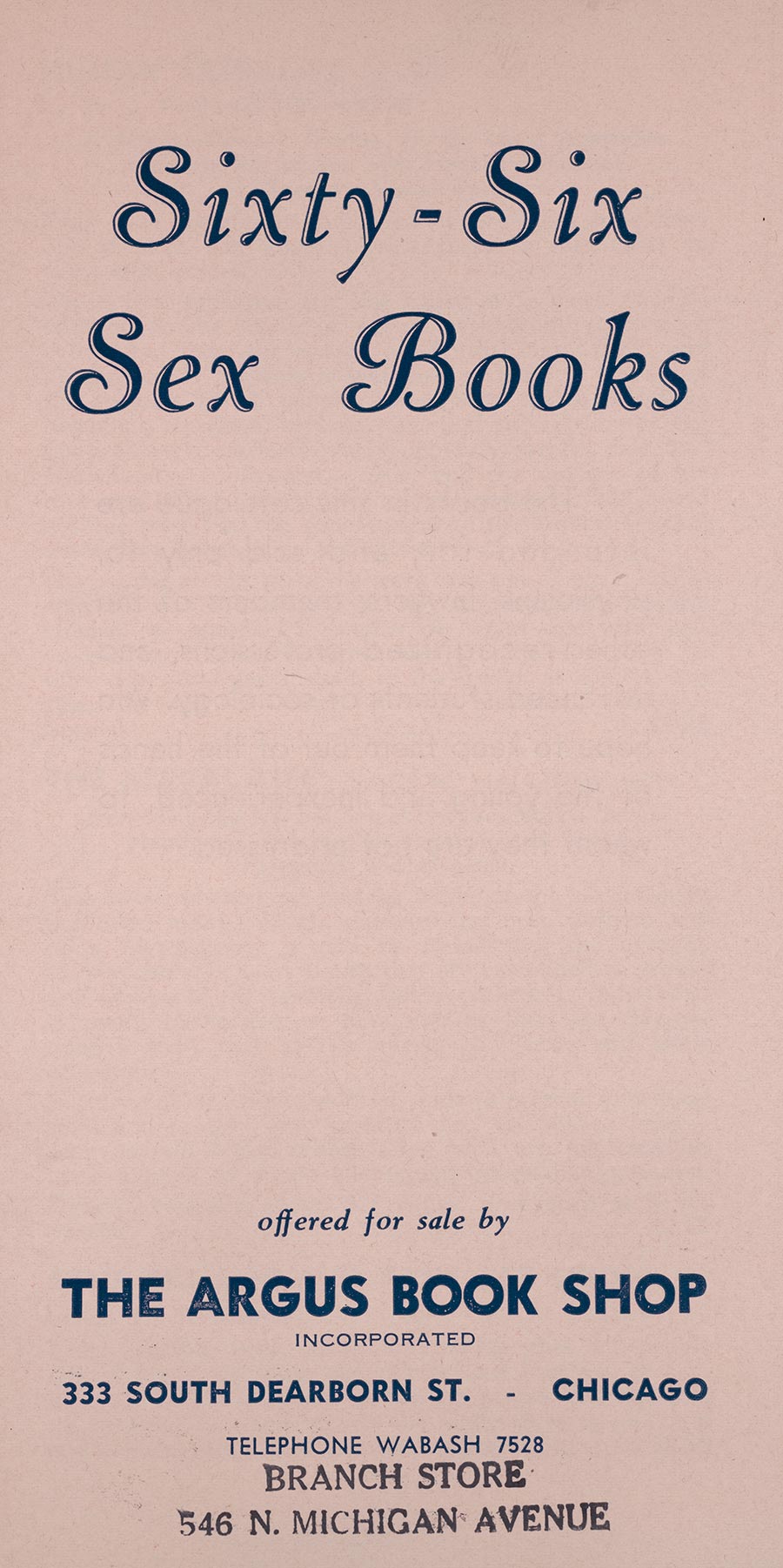
Sixty-Six Sex Books, a catalog from the Argus Book Shop. Included in RB 623859, folder 1. | The Huntington Library, Art Museum, and Botanical Gardens.
Private libraries and collections intentionally focused on the genre of queer history have only more recently been made public. Jim Kepner’s personal Western Gay Archives, accrued from the 1940s, became the International Gay & Lesbian Archives and then was renamed again to ONE National Gay & Lesbian Archives, now housed at USC. Collections like ONE, the June L. Mazer Lesbian Archives in West Hollywood, the GLBT Historical Society in San Francisco, the Lesbian Herstory Archives in New York City, the Transgender Archives at the University of Victoria in Canada, the Leather Archives & Museum in Chicago, and smaller collections like the William Way LGBT Community Center in Philadelphia and the Faulkner Morgan Archive in Lexington, Kentucky—to name only a few whose materials have changed my life—not only channel the preservation of history as a community-building exercise and matter of intergenerational care among chosen family, but also empower us to revisit collections and institutions that are not expressly queer or trans to find what we can. I can triangulate among what these collections have taught me about the queer past, what I know to be true about my own experiences, and what I yearn to rediscover.
That is also true for The Huntington, where I can begin to fill the tantalizing absences marked by publishers’ advertisements and booksellers’ catalogs to build a relationship between two libraries: one destroyed and one thriving. And it’s where I can browse Christopher Isherwood’s library and papers and begin to connect their philosophical and esoteric components to the broader history of library-building among queer bibliophiles over the past 300 years—a history that includes myself, a working-class queen like Karl Giese.
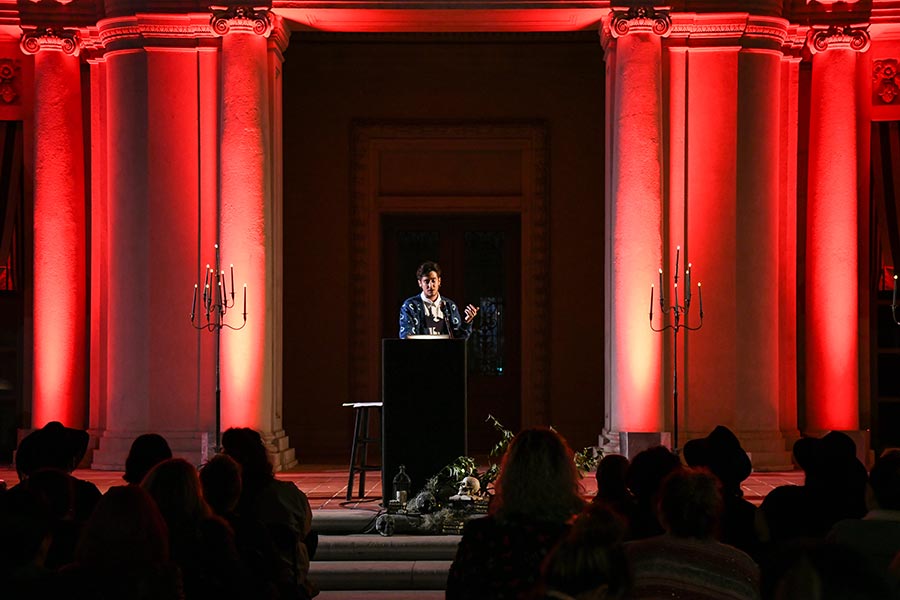
During The Huntington’s Strange Science event in October, Brooke Palmieri gave a talk on the terrace of the Huntington Art Gallery titled “Queer Revolutionary Witchcraft.” The talk focused on how East and West Coast paganism informed the spiritual underpinnings of an LGBTQIA+ liberation movement. | Photo by Linnea Stephan.
Brooke Palmieri is an artist, writer, and educator working at the intersection of memory, history, and gender-bending alternate realities. In 2018, they founded Camp Books, a platform and traveling bookshop promoting access to queer history through affordable prints and magazines, workshops and installations, and the collaborative construction of archives related to LGBTQIA+ activism and the long history of gender nonconformity. From September to November 2023, Palmieri served as the inaugural writer-in-residence at The Huntington, working on a piece of creative nonfiction about witchcraft and gender nonconformity.
